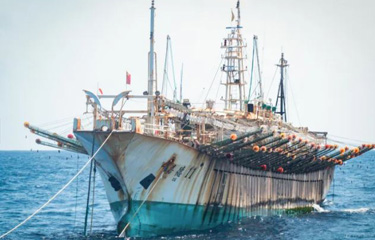Japan importing more Humboldt squid from Peru, while massive Chinese fleet returns

Japan has been importing more Humboldt squid from Peru in recent years, mainly for use in processed products that formerly used domestic Japanese flying squid.
The first year that Japanese Customs reports imports from Peru under the harmonized tariff code 0307.43.030 is 2017. The code covers Japanese flying squid (Todarodes pacificus), jumbo flying squid (Dosidicus gigas, also called Humboldt squid), Japanese squid (Loliolus spp.), shortfin squid (Illex spp.) and sparkling enope squid (Watasenia scintillans). However, the squid that are fished on the west coast of South America from the Galapagos Islands to Southern Chile are mainly Humboldt. The Illex squid is found on the other side of the continent, off the Falkland Islands, Argentina, and Uruguay.
Japanese Customs records show that the quantity imported from Peru in 2017 was 11.6 million kilograms, valued at JPY 2.5 billion (USD 22.8 million, EUR 19.3 million). While, per-kilogram values fluctuate year by year, the volumes since then show a generally increasing trend: to 13.4 million kilograms, valued at JPY 3.8 billion (USD 34.7 million, EUR 29.4 million) in 2018; to 15.3 million kilos, valued at JPY 3.85 billion (USD 35.1 million, EUR 29.7 million) in 2019; and 17.1 million kilos, valued at JPY 3.45 billion (USD 31.5 million, EUR 26.7 million) in 2020. This does not count the squid exported in processed forms.
The Humboldt squid grows from a size of one millimeter to over one meter in just one year, and typically breed and die within one to two years. The range of the squid is expanding with global warming. In the Northern Hemisphere, they have become year-round inhabitants of Monterey Bay, California, U.S.A. and can be sighted as far north as Alaska. In the Southern Hemisphere, they are extending their range into Chile.
Ecuador, Peru’s northern neighbor, was spooked by the sudden arrival in August of 2020 of about 260 Chinese squid-jigging vessels just outside the country’s exclusive economic zone around the Galapagos Islands. However, this has actually been taking place for many years, though the media only focused on it intensively this last year, when Global Fishing Watch began publicizing satellite data that showed the massive scale of the fishing.
The event made Ecuadorian fishing firms realize that if the Chinese were travelling halfway around the world to harvest the squid, they might be missing out on something good at their doorstep. Ecuador does fish squid within its own EEZ, and the country’s Instituto Nacional de Pesca has been promoting a directed Humboldt squid fishery since 2015. However, this is primarily not a targeted fishery, and export processing is not yet well-developed. Currently, squid is taken by driftnets as bycatch and often used as bait in longline fishing for dolphinfish and billfish.
Squid is abundant in the Gulf of Guayaquil. Six industrial vessel licenses, and 30 artisanal vessel licenses are currently allowed under a ministerial agreement. But for Ecuador to take part in fishing nearby international waters and to promote the squid as an export product, the country is looking toward completing vessel conversion, adding either shipboard or shore-side processing with sufficient quality control, creating a marketing system, and conducting further biological studies to gauge the population and understand the interactions with the squid in Peruvian waters.
In the most recent catch data from the Instituto Nacional de Pesca, titled “Web Report of the Giant Squid Resource (Dosidicus gigas) Province of Santa Elena, August 2021,” the artisanal fishery based at the northern end of the Gulf of Guayaquil took a total of 24.6 metric tons. 95.1 percent of this was landed at Puerto Santa Rosa, with the remainder at Puerto Anconcito. This is for August only, at the tail end of the high season. In June, the former landed over 100 MT, and the latter about 60 MT.
Currently, 85 percent of Ecuador’s fishery exports are tuna, mainly landed at the port of Manta, but the fleet is mostly about 40 years old and is losing its competitiveness. Ecuador sees Humboldt squid as a possible lifeline, according to the report.
However, Ecuadorian fishers will face increasing global competition in the fishery. China’s massive fleet is not alone in targeting squid at the edge of South American EEZs. Taiwan and South Korea are also fishing for squid in both the Southern Atlantic and Southern Pacific oceans, though in much smaller numbers, and Spain is part of the Illex fishery off Argentina.
While the fleet sizes of the other players have remained fairly stable, China’s has ballooned from 54 vessels active in the South Pacific to 557 last year, according to the South Pacific Regional Fisheries Management Organization (SPRFMO). China’s catch has exploded from 70,000 metric tons to 358,000 metric tons.
This year, China’s intensive fishing effort has been tracked by environmental conservationist group Sea Shepherd, which followed the Chinese fleet off the Galapagos with embedded reporters from the Associated Press and Spanish language broadcaster Univision. The two media organizations released reports on 24 September, and Sea Shepherd announced plans to release a video mini-documentary on 30 September.
A preview of the Sea Shepherd report found that of the 29 squid jiggers it documented fishing around the Galapagos this summer, 24 had either a history of forced labor allegations; past convictions for illegal fishing; a track record of using multiple electronic identities to elude monitoring organization; or operated “dark” – turning off their mandatory location transponders. Sea Shepherd said it also intercepted a refueling tanker managed by an affiliate of a company accused of violating United Nations sanctions on North Korea.






Share